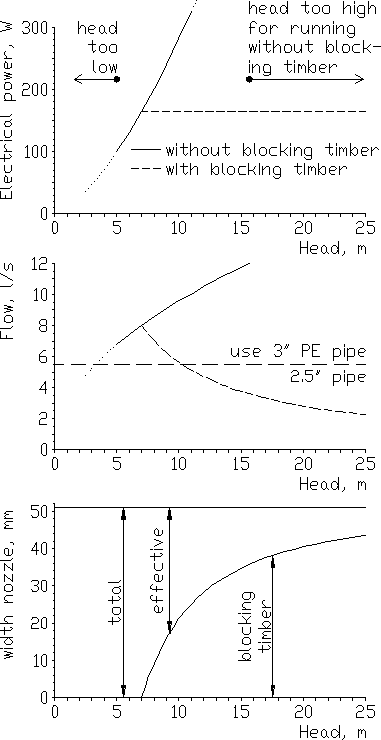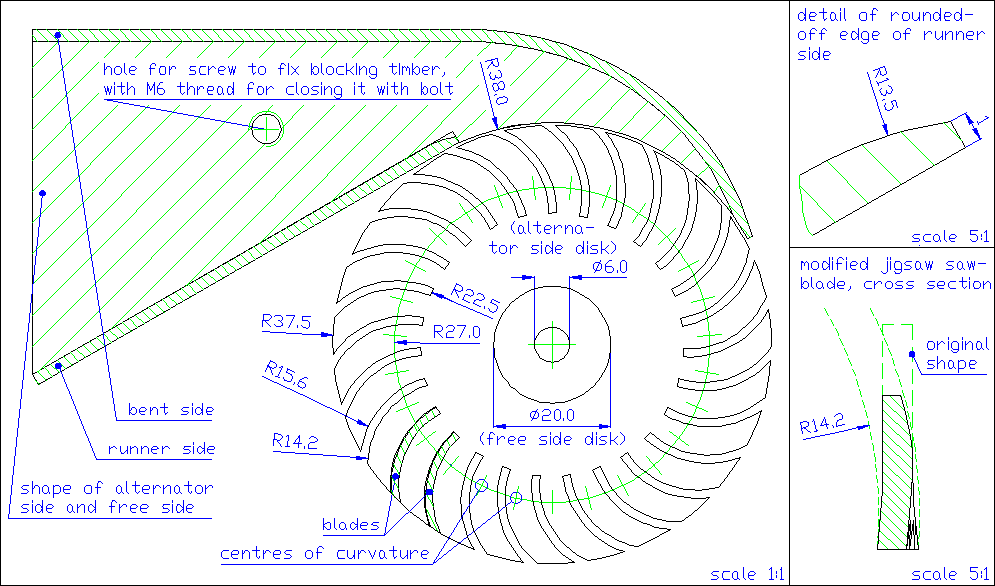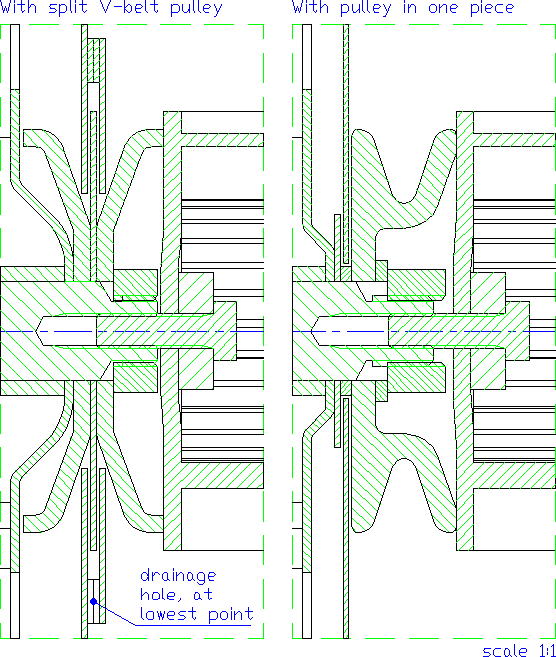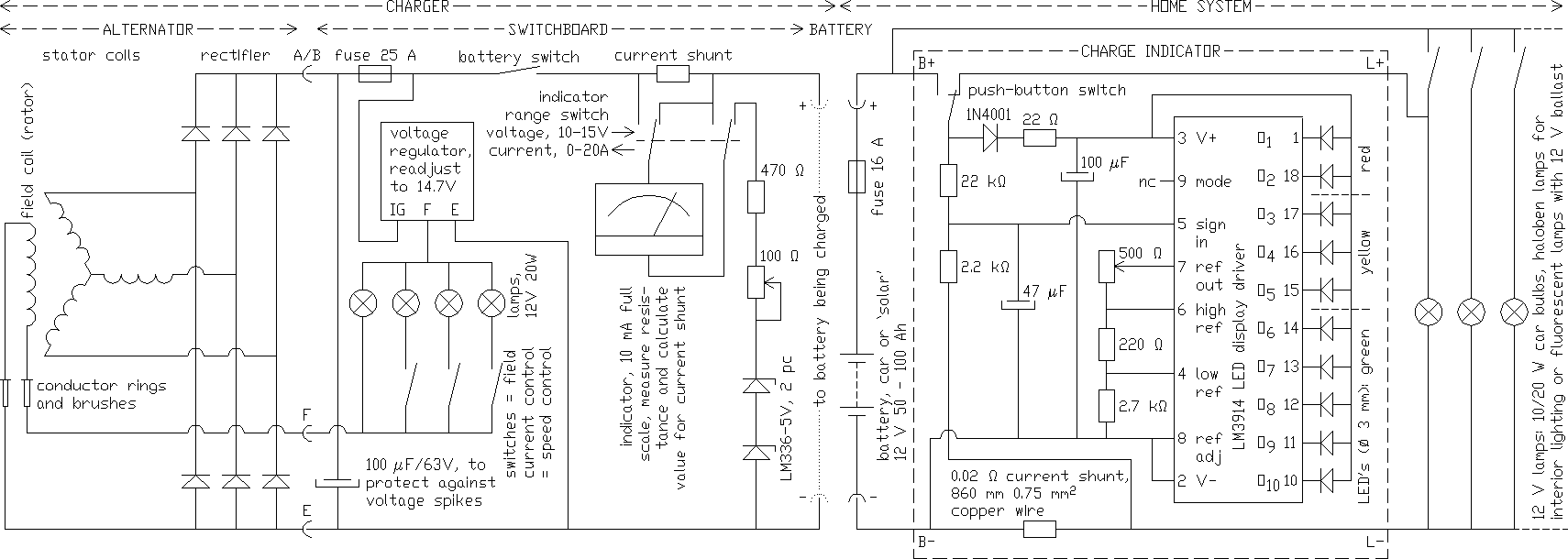| The firefly system consists of 2 major
components: The firefly charger and the home systems. The
charger basically is a second hand car alternator with a
`crossflow' runner mounted directly on the shaft, see
figs. 1, 2 and 3 (see HARVEY, 1993 for a description on
crossflow turbines). It might seem this charger is the
major component as it is the part that generates
electricity. However, economically speaking it is not:
batteries and other materials for the 10 home systems
that are typically served by one charger, are about 5
times as expensive as a locally built charger. Also in
running costs, the batteries are the critical element so
proper battery care is vital. This means among others
that batteries should not be discharged too deep and
should never be left in discharged condition for long.
Therefore the charger should always be ready for charging
batteries, which it will when it is built properly, the
operator is around and knows his/her job and there is
water to power it. The firefly charger is quite
flexible with respect to the head (= water pressure in m)
it can operate at, see the characteristics in fig. 4. At
high head, flow and output power can be reduced by
inserting a blocking timber in the nozzle. Over the whole
head range, the charger can operate at its optimum speed
because field current can be regulated, see fig. 5 for
the electrical circuit of both charger and home system.
The home system includes the battery, lamps, switches
and the wiring to make these work. It also includes the
firefly charge indicator, a small piece of electronics
that shows how far a battery has been discharged by means
of 10 LED's. It is located near the switch of a lamp that
is often used and is activated when this lamp is turned
on. The fact that it lights up will draw the attention of
users, even more so because before showing its final
reading, the LED's indicating a lower voltage light up
briefly. For more accurate readings, there is a push-button
switch to activate the charge indicator without any lamps
being switched on. So prime responsibility for not
discharging batteries too deep, lies with the users who
own them. As a back-up, the operator of the charger
should check whether batteries were discharged too deep
before charging them.
Major advantages of the firefly system are:
It is Cheap: In the Philippines, a
complete charger was estimated to cost $ 150
while the materials for a home system were about
$ 75 (1992 prices, labour done by users not
included). So with 10 users per charger,
investment costs are only $ 90 per user, or about
1/10-th of the investment costs of a solar home
system at the time.
Introducing it is simple: Compared to 220
V A.C. systems, the firefly system needs only few
users to start with and no local electricity grid.
Training needs are less because 12 V is safe to
touch and operators can learn by trial and error.
Finding a suitable site is easier and digging a
canal is less work since it requires only a small
flow and a low head. Also the firefly charger can
be demonstrated by using a motor pump or a
makeshift water source before investing in a
permanent canal, batteries etc.
Local production is possible: Car repair
workshops can produce the mechanical parts of the
charger while electronics repair workshops can
build switchboards and charge indicators.
|

Fig. 4: Charger characteristics.
Notes
Above 7 m head, electrical power would become too high
for charging only one battery. Then output power can be
limited by inserting a blocking timber in the nozzle that
blocks part of nozzle width. Above 15 m head, a blocking
timber of at least half nozzle width is needed to keep
forces on runner blades within limits.These characteristics are
based on an assumed overall efficiency of 0.30 . For a
neatly built charger fitted with a good alternator,
overall efficiencies of up to 0.40 are achieveable. If
electrical power is disappointingly low, check:
- Electrical
system (see fig. 5). As long as the battery is
relatively empty, the voltage regulator should
provide full field current. If not, check its
adjustment and make sure voltage drop to battery
poles is low.
- Measure field
current: If this remains below 2.5 A even with
all field current lamps on, check alternator
brushes. Fit a better seal if brushes have become
wet. Check whether actual speed is close to
optimal speed for turbine (= about 60 % of free
running speed). Reduce or increase the number of
field current lamps being switched on until
charging current is highest.
- Pipe losses (measure
net head at nozzle inlet). To reduce pipe losses,
fit a larger diameter pipe or a wider blocking
timber.
- If runner and
nozzle are built rather crudely, check how much
water is leaking past the runner. Fit the nozzle
closer to the runner to reduce this.
|


 Fig. 3: The seal and the way the runner is
fixed on the alternator shaft.
Fig. 3: The seal and the way the runner is
fixed on the alternator shaft.

